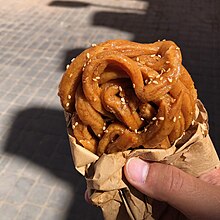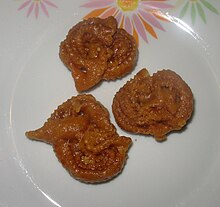|
Chebakia
Shebakia (Arabic: شباكية) or Chebakia, also known as Griwech or Griouech, is a Maghrebi pastry made of strips of dough rolled to resemble a rose, deep-fried until golden, then coated with a syrup made of honey and orange blossom water and sprinkled with sesame.[1][2][3] It is typically consumed during Ramadan and religious celebrations.[1][4] Chebakia is from the Ottoman desserts culture.[5] Chebakia is made using yeast spiced with anise, cinnamon, and saffron.[6] The dough is made from ground sesame seeds mixed with flour and maybe squeezed through a pastry tube or twisted by hand to achieve the flower-like shape.[6][7] It is then fried like a donut. The pastry is often produced in large batches at the start of Ramadan.[8][6] Although it is sweet and is often paired with coffee and tea, Moroccans also eat chebakia with spicy food such as harira.[6]   Similar pastries include the Cartellate and the Fazuelos, though the latter are constructed differently, and are thinner, less dense and from different regions. Names and originEtymologyThe names of Chebbakia, and its size, shape and exact ingredient may vary by region. In Algeria[1] and in Fez, Morocco, it's known as griwech (Moroccan Arabic: ڭريوش or Algerian Arabic: قريوش). In Rabat, as mkherqa (مخرقة). In Salé, as El-qli (القلي). In Ouezzane as lahlou (الحلو), and in some other Moroccan region as kliwech (كليوش).[9][10] HistoryThe origin of this pastry is likely Ottoman, due to its similarity to Eastern pastries such as baklawa in former Ottoman areas, and meshbek in Syria also known as zalabiyeh.[11] In Morocco, a folk origin story claims that chebbakia was invented by an ambulant pastry merchant, who fell in love with a beautiful girl he saw every day at her window, and decided to make honeyed pastries in the shape of her window (Arabic: شباك, shubbak), to give her as a gift.[11] See alsoReferences
External links
|
||||||||||||

